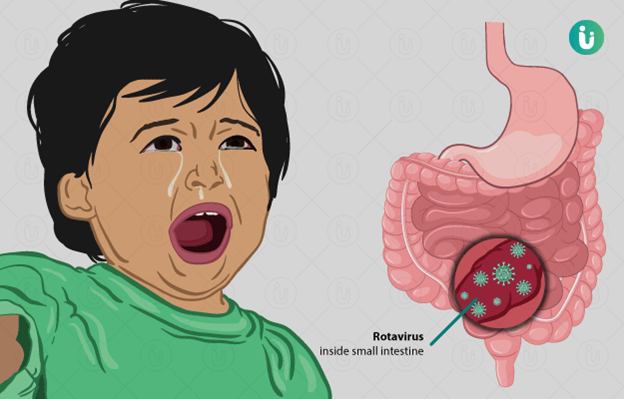The viral pathogen that frequently causes acute diarrhea in young children is:
Rotavirus.
Salmonella organisms.
Shigella organisms.
Giardia organisms.
The Correct Answer is A
The correct answer is choice A: Rotavirus.
Choice A rationale:
Rotavirus is a viral pathogen that frequently causes acute diarrhea in young children. It is highly contagious and is responsible for a significant portion of severe diarrhea cases worldwide. Rotavirus infections are most common in infants and young children, and they can lead to dehydration, especially in developing countries where access to clean water and proper sanitation might be limited.

Choice B rationale:
Salmonella organisms can cause food poisoning and gastrointestinal infections that lead to diarrhea. However, they are more commonly associated with bacterial infections rather than viral-induced acute diarrhea.
Choice C rationale:
Shigella organisms are also bacterial pathogens that cause diarrhea, specifically bacillary dysentery. While they can cause severe diarrhea, they are not the viral pathogen typically responsible for acute diarrhea in young children.
Choice D rationale:
Giardia organisms are parasites that can cause gastrointestinal infections leading to diarrhea. However, they are not viruses, and they are less commonly associated with acute diarrhea in children compared to rotavirus.
Nursing Test Bank
Naxlex Comprehensive Predictor Exams
Related Questions
Correct Answer is A
Explanation
The correct answer is choice A. Wearing cotton underpants.
Choice A rationale:
Wearing cotton underpants is the recommended option to prevent urinary tract infections (UTIs) in young girls. Cotton underpants allow better air circulation, which helps to keep the perineal area dry. This reduces the growth of bacteria and prevents moisture buildup, which are crucial in preventing UTIs. Synthetic fabrics can trap moisture and create a conducive environment for bacterial growth, increasing the risk of UTIs.
Choice B rationale:
Limiting bathing as much as possible is not an appropriate recommendation for preventing UTIs. Hygiene is essential to prevent UTIs, and regular bathing is part of maintaining cleanliness. Overly limiting bathing can lead to poor hygiene practices and may not significantly prevent UTIs, as they are often caused by factors beyond bathing frequency.
Choice C rationale:
Increasing fluids and decreasing salt intake can be beneficial for overall health but may not directly prevent UTIs. While staying hydrated is important for maintaining urinary health, simply increasing fluids and reducing salt intake might not be sufficient to prevent UTIs. Hygiene practices and proper perineal care play a more significant role in preventing UTIs.
Choice D rationale:
Cleansing the perineum with water after voiding is a good hygiene practice, but it alone may not be enough to prevent UTIs. While maintaining cleanliness is crucial, using water to cleanse the perineum after voiding should be combined with other practices, such as wearing cotton underpants and proper wiping techniques, to effectively prevent UTIs.
Correct Answer is C
Explanation
The correct answer is choice C. Decreased oxygen-carrying capacity of blood.
Choice A rationale:
Anemia does not primarily result in a depressed hematopoietic system. In fact, anemia often occurs due to various factors that affect red blood cell production or lifespan. The hematopoietic system can be overactive in response to anemia, attempting to compensate for the reduced oxygen-carrying capacity of the blood.
Choice B rationale:
While some anemias may involve the presence of abnormal hemoglobin (e.g., sickle cell anemia), this is not the primary result of anemia. The primary consequence of anemia is a decreased ability of the blood to carry oxygen to the body's tissues.
Choice C rationale:
The correct choice. Anemia leads to a decreased oxygen-carrying capacity of the blood. Hemoglobin, the protein in red blood cells responsible for carrying oxygen, is reduced in quantity or function in various types of anemia. This results in inadequate oxygen delivery to tissues, potentially causing symptoms such as fatigue, weakness, pallor, and shortness of breath.
Choice D rationale:
Increased blood viscosity is not a primary result of anemia. Anemia tends to reduce blood viscosity because there are fewer red blood cells and less hemoglobin present, which makes the blood more fluid and less viscous. Increased blood viscosity is more commonly associated with conditions like polycythemia, where there is an excess of red blood cells.
Whether you are a student looking to ace your exams or a practicing nurse seeking to enhance your expertise , our nursing education contents will empower you with the confidence and competence to make a difference in the lives of patients and become a respected leader in the healthcare field.
Visit Naxlex, invest in your future and unlock endless possibilities with our unparalleled nursing education contents today
Report Wrong Answer on the Current Question
Do you disagree with the answer? If yes, what is your expected answer? Explain.
Kindly be descriptive with the issue you are facing.
